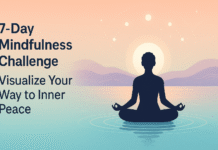If you’ve ever felt overwhelmed by “gratitude lists” or long journaling rituals, here’s a refreshing shift: express thanks for one specific act—just one—and watch what it does to your mood, your focus, and your relationships. In this guide, you’ll learn how a single, well-delivered expression of gratitude can reset your attention, interrupt stress loops, and create an upward spiral of motivation. You’ll get a step-by-step method, beginner-friendly scripts, common pitfalls and fixes, and a simple four-week plan to make the “power of one” part of your life.
Key takeaways
- Small is powerful: Focusing your thanks on one concrete act drives clarity, emotion, and follow-through.
- Science-backed benefits: Gratitude practices are linked with better well-being, sleep, mood, and relationship quality.
- Beginner-proof method: A short, structured “one-act” protocol (identify → feel → express → follow-up) takes 5–10 minutes.
- Measurable progress: Track mood, energy, and sleep quality with fast, low-friction metrics.
- Sustainable cadence: One deliberate expression weekly is enough to build momentum; scale up later if you like.
- Ethical and safe: Gratitude is not people-pleasing. Use it with boundaries and discernment.
Note: Gratitude practices can support mental well-being but aren’t a substitute for professional care. If you’re struggling with anxiety, depression, trauma, or relationship safety, consult a qualified professional for personalized guidance.
What the “Power of One” Really Means
What it is (and why it works).
The “power of one” is the practice of isolating a single helpful act someone did—holding the elevator, reviewing your draft, checking on you—and expressing specific, heartfelt thanks for that act. When you zoom in on one moment, your brain gets a crisp signal instead of a fuzzy feeling. That clarity intensifies positive emotion, makes your message more sincere, and makes the other person feel truly seen. Over time, consistently noticing and naming one act shifts your baseline mindset toward appreciation and possibility.
Core benefits or purpose.
- Sharper attention: You train your mind to scan for what’s working.
- Stronger bonds: The other person gets concrete feedback about what mattered.
- Upward spiral of effort: Recognition fuels repeat helpfulness—yours and theirs.
- Stress interruption: Positive emotion briefly widens perspective and loosens tunnel vision.
Requirements/prerequisites and low-cost alternatives.
- Requirements: Five quiet minutes; a way to send your message (voice, text, note).
- Nice-to-haves: A small notepad or notes app; a recurring reminder.
- Low-cost alternatives: If expression feels hard, start private—write it for yourself first.
Step-by-step (beginner friendly).
- Pinpoint one act. Name who did what, when, and how it helped.
- Feel it for 10 seconds. Rehearse the moment; notice the relief, warmth, or momentum.
- Express it. Use one of the scripts under “Say It Well” (text, voice, or note).
- Follow-up signal. A week later, reference the impact (“I used your tip again”).
Beginner modifications and progressions.
- Modify: Write a 2–3 sentence note you never send (training wheels for a week).
- Progress: Deliver one message live (in person or voice); later, try a short letter.
Recommended frequency, duration, and metrics.
- Frequency: 1 deliberate expression per week (optionally add a second).
- Duration: 5–10 minutes.
- Metrics (KPIs): Mood (0–10), energy (0–10), sleep quality (0–10), and a weekly “connection count” (how many people you thanked).
Safety, caveats, and common mistakes.
- Boundaries: Gratitude isn’t an apology, debt, or permission for misuse.
- Fit: Avoid thanking someone for an act that violated your needs or values.
- Common mistakes: Being vague (“Thanks for everything”), over-stuffing (“…and also”), or delaying until it feels “perfect.”
Mini-plan (2–3 steps).
- Today: pick one act; write a three-sentence note.
- Tomorrow: send it.
- Next week: a one-line follow-up noting the ripple effect.
Why a Single Act Can Reset Your Mind: The Psychology in Plain English
What it is and benefits/purpose.
One vivid positive moment can widen your mental lens for a while. When you shine a spotlight on a specific help you received, you create a brief “broadening” window: options look a little wider, people a little kinder, and your next step a little clearer. This broadening makes it easier to problem-solve, connect, and take constructive action. That’s how a one-act practice starts changing your overall mindset—not by ignoring problems, but by adding enough light to see more of the room.
Requirements/prerequisites.
None beyond willingness to notice specifics and test the method.
Step-by-step to harness the effect.
- Name the benefit precisely: “You sent the draft back by lunch; I met the deadline.”
- Spot the ‘why’: “You took time despite your own workload.”
- State the shift: “It lowered my stress and helped me ask for help sooner next time.”
Beginner modifications and progressions.
- Modify: If emotion feels muted, pair the memory with breath—inhale 4, hold 2, exhale 6—and re-visualize the moment.
- Progress: Add a small action repercussion (“I paid it forward by helping Sarah with slides”).
Recommended frequency/duration/metrics.
- Frequency: Once weekly is sufficient; the “broadening” window can linger.
- Metric: After expressing thanks, do a 60-second “options scan”—write two small next steps you now see.
Safety and caveats.
- Positive reframing helps, but don’t use gratitude to rationalize staying in unsafe dynamics.
- If the relationship is complicated, try private gratitude (journal or unsent note) first.
Mini-plan.
- Capture a memory, write the “what/why/shift” trio, share it with a safe person or keep it private for now.
Pick the Moment: How to Choose the Single Act
What it is and benefits/purpose.
Selection is everything. The best “one act” is recent, concrete, and consequential to you (even if small). Choosing well boosts emotional intensity and sincerity.
Requirements/prerequisites.
A 24–48 hour lookback window is ideal, but older moments work if they’re vivid.
Step-by-step selection filter.
- Recency: Did it happen in the last week? (If not, is it still sharp?)
- Specificity: Can you describe it in one sentence with a verb?
- Impact: Did it reduce stress, save time, or change your plan?
- Deliverability: Are you comfortable thanking the person directly? If not, journal it privately.
Beginner modifications and progressions.
- Modify: Start with low-stakes targets (barista, coworker you know casually).
- Progress: Tackle a high-impact, long-overdue thank-you (mentor, teacher).
Recommended frequency/duration/metrics.
- Frequency: Select one act every Sunday night; express thanks Monday morning.
- Metric: Track “selection ease” (0–10). It rises as your attention tunes toward specifics.
Safety, caveats, and common mistakes.
- Avoid generic groups (“Thanks to the whole team”) at the start—diffusion blurs sincerity.
- Don’t pick acts that feel emotionally entangled until you build skill.
Mini-plan.
- Write three candidate acts; circle the one that gives you the strongest bodily “yes” (warmth, relief, clarity). Send that one.
Say It Well: Scripts and Channels That Amplify Sincerity
What it is and benefits/purpose.
Your goal is to make the other person understand exactly what they did, why it mattered, and how it changed something for you. This creates a clear feedback loop that builds trust and future cooperation.
Requirements/prerequisites.
Choose a channel that reduces friction: text, email, voice note, handwritten card, or in-person.
Step-by-step structure (the 3–2–1).
- 3 specifics: What you did → why it helped → what changed.
- 2 feelings: How I felt then → how I feel now.
- 1 bridge: What I’ll do next time / how I’ll pay it forward.
Beginner scripts (copy/paste and personalize).
- Text (work): “Thanks for sending the data cuts by noon. That let me finish the brief before the client call, and my stress dropped a ton. I’m using your template for next week’s report—game-changer.”
- Email (mentor): “Last Tuesday you stayed late to review my outline. Your question about the audience clarified my approach and helped me finish on time. I felt supported and less stuck. I’ll open with the user story, per your tip, in the next draft.”
- Voice note (friend): “Your message this morning—‘thinking of you’—cut through the noise. I felt seen and lighter. I booked the appointment we talked about. Thanks for nudging me.”
Progressions.
- Handwritten note: 5 sentences using the 3–2–1 structure.
- Live delivery: Ask for 2 minutes; read your note; end with a hug/handshake if appropriate.
- Long-form letter: One page telling the story of the act and its ripple effects.
Recommended frequency/duration/metrics.
- Frequency: One message weekly; increase to two if it feels energizing.
- Duration: 3–7 minutes for text/voice; 10–15 for a letter.
- Metrics: “Delivery discomfort” (0–10) and “connection warmth” (0–10) right after.
Safety and caveats.
- Consider cultural norms and power dynamics; keep it professional at work.
- Avoid loaded topics (money, favors that create obligation). Keep focus on the act and its impact.
Mini-plan.
- Pick one channel you’ll actually use. Write the message. Read it aloud once; send.
The One-Act Gratitude Method (Full Protocol)
Purpose.
A repeatable, five-minute ritual that fits in your calendar and actually gets done.
Requirements/prerequisites.
- Calendar reminder (weekly).
- Notes app (or index card).
- A quiet moment.
Step-by-step (5 minutes).
- Scan (1 min): “What one act last week made my day easier or brighter?”
- Feel (30 sec): Replay the moment; name one emotion (“relief,” “encouraged”).
- Draft (2 min): Write a 3–5 sentence note (use 3–2–1).
- Send (30 sec): Hit send or put the card on tomorrow’s to-do.
- Log (1 min): Record mood/energy (0–10) and one short “next step” you now see.
Beginner modifications and progressions.
- Modify: Keep a “one-act” folder; even if you don’t send, save drafts.
- Progress: Schedule one live delivery per month; once per quarter, write a one-page gratitude letter.
Recommended frequency/duration/metrics.
- Minimum viable cadence: Once per week.
- Optional booster: Add a 10-second micro-thank daily (silent or quick DM).
- Metrics to track weekly: Mood, energy, sleep quality, and “help requested” count (did gratitude make it easier to ask for help?).
Safety, caveats, and common mistakes.
- Mistake: Turning the ritual into a chore—keep it short; let sincerity trump polish.
- Mistake: Using gratitude to avoid conflict—thank someone and still have the hard conversation.
- Caveat: If a person interprets thanks as an invitation you don’t intend, clarify boundaries kindly.
Mini-plan (2–3 steps).
- Set a recurring 10-minute block titled “One Act Thank-You.”
- Use a saved script template.
- Log your metrics right after sending.
Quick-Start Checklist
- I can describe one specific act in one sentence.
- I know why it mattered and how it changed something.
- I picked a channel I’ll actually use this week.
- My message contains 3 specifics, 2 feelings, 1 bridge.
- I scheduled a weekly reminder.
- I decided on 2–3 metrics (mood, energy, sleep quality).
Troubleshooting & Common Pitfalls
“I can’t think of anything.”
Lower the bar. Look for micro-acts: someone held the door, forwarded a link, answered quickly, smiled when you needed it. Check your calendar and messages for clues.
“I feel awkward.”
Use text or email. Read your note out loud once. Keep it short. Awkward fades; sincerity lands.
“I’m afraid it’ll create obligation.”
Gratitude reports your reality; it doesn’t promise future favors. Keep your message descriptive, not transactional.
“I’m dealing with tough stuff—gratitude feels fake.”
You don’t need to feel “great.” Aim for accurate. “That message helped me book an appointment I was dreading” is honest and powerful.
“I thanked someone and nothing changed.”
You’re training your attention and behavior. Keep the practice, watch your mood, clarity, and next-step momentum.
“I thanked the wrong person.”
If it felt off, note what you learned about boundaries or tone. Try again next week with a lower-stakes target.
“I over-explained and lost the point.”
Return to 3–2–1. Specific → helpful → changed; feelings then bridge. Done.
How to Measure Progress (So You Know It’s Working)
What to measure.
- Mood, energy, sleep quality (0–10 scales—fast to log).
- Connection warmth (0–10 immediately after expressing thanks).
- Action follow-through: Did you take one next step within 24 hours?
- Help-seeking ease: 0–10 rating: “How easy was it to ask for help this week?”
Tools and low-friction options.
- Notes app template:
- “Act thanked → channel → mood/energy/sleep → connection warmth → one next step.”
- Paper index card you keep by your laptop.
- Weekly reflection: “What pattern am I noticing?” (e.g., mornings better, meetings smoother).
Progressions.
- After two weeks, add a gratitude letter (one page) to someone meaningful.
- After four weeks, experiment with a brief evening note: “One act I appreciated today was…”
Safety/caveats.
If tracking breeds pressure, reduce to one KPI (mood) and a single sentence reflection.
Mini-plan.
- Today: create a notes template.
- This week: log metrics after each expression.
- Month-end: skim your logs; pick one insight and one tweak.
Use Cases & Mini-Plans (Work, Home, Health)
Workplace
Purpose. Build psychological safety and collaboration with specificity.
Requirements. Work-appropriate tone; channel (email/Slack).
Steps.
- Thank a teammate for a discrete contribution (data pull, quick review).
- Show the impact (deadline met, bug caught).
- Bridge to future (“I’ll reuse your checklist next sprint”).
Beginner mod. Start with peers; keep it 3 sentences.
Progression. Monthly gratitude note to a cross-team partner.
Frequency/KPIs. 1–2 messages/week; track response rate and project friction.
Safety. Keep it professional; avoid personal compliments that could be misread.
Mini-plan. Friday wrap-up: send one “one-act” note before logging off.
Close relationships
Purpose. Make care visible; prevent taking each other for granted.
Requirements. Short window of privacy.
Steps.
- Name the act (“You folded the laundry after your long shift”).
- Share the effect (“I felt cared for; it freed my evening”).
- Bridge (“I’m handling dinner tomorrow”).
Beginner mod. Start with a sticky note on the fridge.
Progression. Weekly 2-minute gratitude check-in.
Safety. Gratitude coexists with boundaries and fair division of labor.
Mini-plan. Sunday night: one text or whisper of thanks for a tiny, timely act.
Parenting
Purpose. Reinforce helpful behaviors with clear feedback.
Requirements. Age-appropriate language.
Steps.
- Specific behavior (“You put your shoes away without me asking”).
- Emotion (“That helped me feel calm before school”).
- Bridge (“Let’s read an extra chapter tonight”).
Beginner mod. Use stickers or quick drawings.
Progression. Invite child to name one act they appreciated.
Safety. Keep praise sincere, not overblown.
Mini-plan. Bedtime: one sentence of thanks for one act.
Self-compassion / personal growth
Purpose. Reduce self-criticism; build momentum.
Requirements. Willingness to notice your own efforts.
Steps.
- Name one micro-act you did (took a walk; sent a tough email).
- Feel the shift (relief, pride).
- Future you (“I’ll set a 10-minute timer again tomorrow”).
Beginner mod. Write to yourself in second person (“You showed up”).
Progression. Monthly letter to past you acknowledging one tough, brave act.
Safety. This isn’t excusing harm; it’s reinforcing adaptive effort.
Mini-plan. End of day: jot one sentence, “One thing I did right…”
Health and recovery contexts
Purpose. Support adherence and resilience.
Requirements. Align with your provider’s plan.
Steps.
- Thank a nurse, trainer, or friend for a specific support action.
- Name how it improved rest, motivation, or follow-through.
- Bridge to your next step (meds, workout, appointment).
Beginner mod. If direct thanks feels heavy, start with a card.
Progression. A gratitude letter after a milestone (end of PT, race day).
Safety. Keep medical boundaries; gratitude doesn’t replace clinical care.
Mini-plan. After each appointment, send one two-line message noting the act and impact.
Advanced Progressions: From One Act to a Sustainable Practice
1) Gratitude stacking (monthly).
Week 4, assemble three single-act notes into a short letter telling the “ripple story”: the original act, its next-step effect, and what you did with that momentum.
2) Rotating channels.
Alternate text, voice, handwritten. Variety keeps motivation high.
3) Cadence experiments.
Try “Micro-Mondays” (10-second thank-you ping) + “One-Act Fridays” (full 3–2–1 message). Keep what sticks.
4) Reflection prompts.
- What kinds of acts affect me most?
- Who shows up in quiet ways I’ve missed?
- Where does gratitude help me take braver actions?
A Simple 4-Week Starter Plan
Goal: Build a once-weekly one-act gratitude habit, measure personal impact, and explore one letter-length expression.
KPIs: Mood, energy, sleep quality (0–10), connection warmth (0–10), weekly “help-seeking ease” (0–10).
Week 1 — Start small
- Act: Pick one micro-act from the past 72 hours.
- Channel: Text or DM.
- Script: Use 3–2–1.
- Timebox: 7 minutes.
- Track: Mood/energy before and after.
- Win condition: You sent one message.
Week 2 — Go slightly deeper
- Act: Choose a work-related contribution.
- Channel: Email with subject “Quick thank-you.”
- Add-on: Log one clear next step the thank-you made easier.
- Track: Sleep quality that night (0–10).
Week 3 — Live delivery
- Act: Select something a friend or partner did that eased your week.
- Channel: In-person or voice note.
- Add-on: State your bridge (“I’ll use that approach again Friday”).
- Track: Connection warmth immediately after (0–10).
Week 4 — One-page letter
- Act: A mentor/teacher/family member whose single act still echoes.
- Channel: Handwritten or long email.
- Add-on: Share one ripple effect months/years later.
- Track: All KPIs; compare to Week 1.
- Retrospective: Keep the weekly cadence? Adjust channel? What felt most energizing?
Safety, Ethics, and Boundaries (Read This, Then Thank Freely)
- Gratitude is descriptive, not prescriptive. It doesn’t obligate you or the other person.
- Keep thanks separate from unresolved issues. You can appreciate an act and still address a conflict later.
- Don’t ignore power dynamics. In workplaces or sensitive relationships, keep tone professional and neutral.
- If a person uses your thanks to push boundaries, restate limits kindly but firmly.
Frequently Asked Questions
1) Will one tiny thank-you really change anything?
Yes—because it changes what you notice and how you show up. Even a single, specific expression boosts connection and motivation. Do it weekly and watch the compounding effect.
2) What if I’m introverted or hate sappy messages?
Keep it factual. “You did X; it saved me Y; I felt Z; I’ll do Q next time.” Sincerity beats sentimentality.
3) How long should the message be?
Three to five sentences. If you feel called, write a one-page letter once a month.
4) Is it better to do daily micro-thanks or one solid weekly note?
If you’re starting out, one weekly message wins. Add micro-thanks later if it feels natural.
5) What if the person brushes it off?
That’s about their comfort with praise, not the value of your message. You still trained your attention and strengthened your own follow-through.
6) Can I do this privately without telling anyone?
Absolutely. Private gratitude still sharpens attention and lifts mood. Consider sending occasionally to reinforce relationships.
7) How do I avoid sounding performative at work?
Be concrete and brief. Emphasize the task and impact. Avoid flattery; stick to facts.
8) What if gratitude makes me minimize real problems?
Use gratitude alongside honest problem-solving. If something needs addressing, address it. Gratitude is a light, not a blindfold.
9) Who should I start with?
Start low-stakes: a colleague who replied quickly, a friend who checked in, someone who made your day smoother. Save complex relationships for later.
10) What if I missed the moment and it’s been months (or years)?
Late is often powerful. Tell the short story; share how the act continues to shape you.
11) Can this help with sleep or stress?
Many people report better wind-down and calmer evenings when they end the day by recalling a specific helpful act. Try a two-minute note an hour before bed and track your sleep quality.
12) How do I keep the habit going?
Calendar it. Use a template. Pair it with a trigger (Friday closeout, Sunday planning). Review your metrics monthly to see the payoff.
Conclusion
A single, specific “thank you” is deceptively powerful. It sharpens your attention, lifts your mood, strengthens bonds, and nudges you toward better choices—all in a practice you can complete in minutes. Start with one act this week. Keep it concrete, short, and sincere. Then notice what opens up.
CTA: Pick one person, one act, and send a three-sentence thank-you today.
References
- Counting blessings versus burdens: an experimental investigation of gratitude and subjective well-being in daily life. Journal of Personality and Social Psychology (via PubMed). 2003 Feb. https://pubmed.ncbi.nlm.nih.gov/12585811/
- Counting Blessings Versus Burdens: An Experimental Investigation of Gratitude and Subjective Well-Being in Daily Life. Greater Good Science Center (PDF of article). 2003. https://greatergood.berkeley.edu/pdfs/GratitudePDFs/6Emmons-BlessingsBurdens.pdf
- Positive psychology progress: empirical validation of interventions. American Psychologist (via PubMed). 2005 Jul. https://pubmed.ncbi.nlm.nih.gov/16045394/
- Gratitude influences sleep through the mechanism of pre-sleep cognitions. Journal of Psychosomatic Research (via PubMed). 2009 Jan. https://pubmed.ncbi.nlm.nih.gov/19073292/
- Gratitude influences sleep through more positive and less negative pre-sleep cognitions (PDF). Greater Good Science Center (PDF of article). 2009. https://greatergood.berkeley.edu/images/uploads/Wood_et_al._2009_.pdf
- The effects of gratitude expression on neural activity. NeuroImage (via PubMed). 2016 Jan. https://pubmed.ncbi.nlm.nih.gov/26746580/
- A pilot randomized study of a gratitude journaling intervention on HRV and inflammatory biomarkers in Stage B heart failure patients. Psychosomatic Medicine (via PubMed Central). 2016 Jun. https://pmc.ncbi.nlm.nih.gov/articles/PMC4927423/
- The role of gratitude in spiritual well-being in asymptomatic heart failure patients. (via PubMed Central). 2015 Jul. https://pmc.ncbi.nlm.nih.gov/articles/PMC4507265/
- Gratitude and well-being: a review and theoretical integration. Clinical Psychology Review (via PubMed). 2010 Aug. https://pubmed.ncbi.nlm.nih.gov/20451313/





































Your point of view caught my eye and was very interesting. Thanks. I have a question for you.